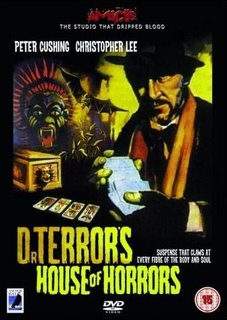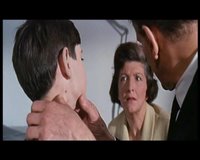
Director: Freddie Francis
Release Date: 1965
Contains spoilers
This was the first horror film by Amicus and paved the way for their trademark “compilation of short films in a feature” it also has some very familiar faces. Five men get onto a train when a sixth man gets into the carriage with them. He is Dr Schreck (Peter Cushing, who looks fantastic with beard). The good doctor offers to pass the time on their journey by reading their tarot, and each tale is the reading.
The tales are “werewolf” about, not surprisingly, a werewolf curse. “Creeping Vine” tells the tale of a sentient plant with killer tendencies. “Voodoo” is a tale of a musician (Roy Castle) who steals the music from a voodoo ceremony and features (bizarrely) a couple of tunes sung by Kenny Lynch. “Disembodied Hand” is the strongest story and stars Christopher Lee in a tale of an art critic who is haunted by a severed hand. The final tale is called “Vampire” and it is that we are concerned with.
The film lasts some fourteen minutes and begins as Dr Bob Carroll (Donald Sutherland) carries his new  French bride Nicole (Jennifer Jayne) over the threshold of his New England home. As she looks around the house he goes to make food and, in a well observed piece of realism (given he had been a bachelor) he opens up a can of beans, accidentally cutting his finger. He is going to wash the cut when Nicole takes his finger and sucks the blood away.
French bride Nicole (Jennifer Jayne) over the threshold of his New England home. As she looks around the house he goes to make food and, in a well observed piece of realism (given he had been a bachelor) he opens up a can of beans, accidentally cutting his finger. He is going to wash the cut when Nicole takes his finger and sucks the blood away.
That night, as he sleeps, she gets up out of bed and then we see the shadow of a bat. Given it is obvious to us that she is a vampire it is worth pointing out that she can go out into the sun and casts a reflection.
The next morning he is picked up, to be taken to the clinic where he works, by his colleague Dr Blake (Max Adrian). It appears that Nicole seems cold towards Blake, a reaction unfortunately not explored properly by the film. At the clinic Bob tells Blake about a case that has him puzzled.  A young boy shows all the signs of anaemia but, as Bob explains, it is not the quality but the quantity of blood that seems to be the problem. Blake takes a look at the boy and notices puncture marks upon his neck. He tells Bob that, had they lived in medieval times, he would suggest a vampire attack.
A young boy shows all the signs of anaemia but, as Bob explains, it is not the quality but the quantity of blood that seems to be the problem. Blake takes a look at the boy and notices puncture marks upon his neck. He tells Bob that, had they lived in medieval times, he would suggest a vampire attack.
Over their evening meal Bob tells Nicole about the case and says that Blake is running tests in his workshop. We see Blake leave the workshop and, cut to a pair of ladies legs coming down the stairs towards him. He senses someone is there and, just before exiting the building, climbs back up the stairs (the female legs now go upstairs, keeping his pursuer out of sight). He gets to the level of his workshop and a bat flies towards him. My main issue with this scene was the concept that neither Blake (fair enough) nor the audience could see who his pursuer was. It was obviously Nicole and it is a short film, not long enough to bother trying to build false doubt, I’m afraid.
Blake tells Bob about the events and Bob asks why the bat didn’t attack. Blake has realised that, when he threw his arms up to protect himself they made a sign of the cross. Blake goes in to see a patient, a young boy (I am unclear if it is the same boy as before) with puncture wounds in his neck. He tells the mother that he wants to watch over the boy that night. He does keep watch, but holds a gun and, as he spots something coming towards the room, he closes the window. A bat flies towards the window and Blake shoots through it, hitting the bat.
 Bob is woken by a crash. He sees Nicole by the window with blood on her hand; she says she cut it shutting the window. I liked this idea of the wound in bat form being apparent in human form, it is a device often used in werewolf stories but not that often in the vampire genre.
Bob is woken by a crash. He sees Nicole by the window with blood on her hand; she says she cut it shutting the window. I liked this idea of the wound in bat form being apparent in human form, it is a device often used in werewolf stories but not that often in the vampire genre.
The next day Blake is carving a stake. Bob protests that Nicole is his wife and Blake explains that a vampire is a spirit that has taken residence in a human body. He also says that if a victim of a vampire dies they too will be a vampire and the only way to kill a vampire is by stake through the heart. He asks Bob to watch her that evening and, “When she returns…” He hands the young doctor the stake. 
Bob is awake, though feigning sleep, when a bat flies into the room and becomes Nicole, who climbs back into bed. He turns her over, tells her that he loves her and then raises the stake.
The film is, of course, short, but it is a fairly nicely put together story and has a great twist at the end, which I’m not going to reveal. Unfortunately the story is so short we have to take a lot on trust. It is difficult to see how Bob could be so easily convinced to take the stake, especially as it is to kill the woman he loves, but there is no time for the character to really express doubt and no time for exposition. The characters could have been fascinating but there is no development at all.
The whole collection is, on the whole, worth seeing, especially as it contains Lee and Cushing (even if Cushing is simply the link between films). However some of the stories, especially “Voodoo” and “Creeping Vine”, fall very flat indeed. The casting of Sutherland came as a surprise when I first viewed this as I just didn’t expect to see him in a low budget 1960s British horror. Of course it would not be his only foray into vampire genre movies with roles in the motion picture “Buffy the Vampire Slayer” (1992) and “‘Salem’s Lot” (2004), unfortunately the film is so short that he doesn’t really get chance to shine.
When it comes to the score we are more concerned with the vampire story, it is this short alone that I am scoring and I’m forced to keep this to 4 out of 10, it is an inventive enough story, for all its bare bones, with a great twist, but ultimately too short to stand out enough to rise above a less than average score. A further review, of the film as a whole, can be found over at Exclamation Mark's Vintage SciFi/Horror Review.
A trailer can be found here, unfortunately it doesn’t contain footage from “vampire”. The imdb page is here.
Sunday, June 25, 2006
Dr Terror’s House of Horrors - review
Subscribe to:
Post Comments (Atom)














2 comments:
I think if they would have edited the Voodoo story more and used the extra time for the vampire tale, it would have been a better segment.
That twist ending really did take me by surprise, though.
The only thing positive about the voodoo section was that Kenny Lynch was in it! Let me explain, some time ago I went to lunch with a group of people and, for reasons that completley escape me we developed a game of trying to crow-bar Kenny Lynch into conversations.
Getting this DVD offered me a legitimate in (small things amuse small minds lol!)
That said, I'd never complain about using extra time on a vampire tale - I did find with these that perhaps having five tales was too much and if they had pared to four (or even three) they'd probably have made much more superior movies.
Post a Comment